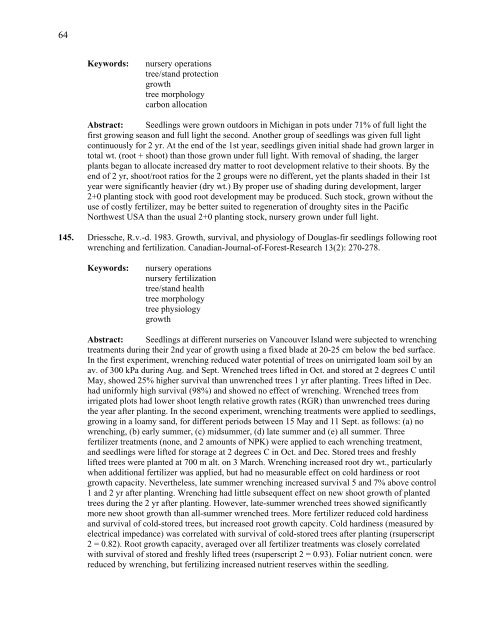IntensIve sIlvIculture - Forest Science Labs - Research Network ...
IntensIve sIlvIculture - Forest Science Labs - Research Network ...
IntensIve sIlvIculture - Forest Science Labs - Research Network ...
Create successful ePaper yourself
Turn your PDF publications into a flip-book with our unique Google optimized e-Paper software.
64<br />
Keywords: nursery operations<br />
tree/stand protection<br />
growth<br />
tree morphology<br />
carbon allocation<br />
Abstract: Seedlings were grown outdoors in Michigan in pots under 71% of full light the<br />
first growing season and full light the second. Another group of seedlings was given full light<br />
continuously for 2 yr. At the end of the 1st year, seedlings given initial shade had grown larger in<br />
total wt. (root + shoot) than those grown under full light. With removal of shading, the larger<br />
plants began to allocate increased dry matter to root development relative to their shoots. By the<br />
end of 2 yr, shoot/root ratios for the 2 groups were no different, yet the plants shaded in their 1st<br />
year were significantly heavier (dry wt.) By proper use of shading during development, larger<br />
2+0 planting stock with good root development may be produced. Such stock, grown without the<br />
use of costly fertilizer, may be better suited to regeneration of droughty sites in the Pacific<br />
Northwest USA than the usual 2+0 planting stock, nursery grown under full light.<br />
145. Driessche, R.v.-d. 1983. Growth, survival, and physiology of Douglas-fir seedlings following root<br />
wrenching and fertilization. Canadian-Journal-of-<strong>Forest</strong>-<strong>Research</strong> 13(2): 270-278.<br />
Keywords: nursery operations<br />
nursery fertilization<br />
tree/stand health<br />
tree morphology<br />
tree physiology<br />
growth<br />
Abstract: Seedlings at different nurseries on Vancouver Island were subjected to wrenching<br />
treatments during their 2nd year of growth using a fixed blade at 20-25 cm below the bed surface.<br />
In the first experiment, wrenching reduced water potential of trees on unirrigated loam soil by an<br />
av. of 300 kPa during Aug. and Sept. Wrenched trees lifted in Oct. and stored at 2 degrees C until<br />
May, showed 25% higher survival than unwrenched trees 1 yr after planting. Trees lifted in Dec.<br />
had uniformly high survival (98%) and showed no effect of wrenching. Wrenched trees from<br />
irrigated plots had lower shoot length relative growth rates (RGR) than unwrenched trees during<br />
the year after planting. In the second experiment, wrenching treatments were applied to seedlings,<br />
growing in a loamy sand, for different periods between 15 May and 11 Sept. as follows: (a) no<br />
wrenching, (b) early summer, (c) midsummer, (d) late summer and (e) all summer. Three<br />
fertilizer treatments (none, and 2 amounts of NPK) were applied to each wrenching treatment,<br />
and seedlings were lifted for storage at 2 degrees C in Oct. and Dec. Stored trees and freshly<br />
lifted trees were planted at 700 m alt. on 3 March. Wrenching increased root dry wt., particularly<br />
when additional fertilizer was applied, but had no measurable effect on cold hardiness or root<br />
growth capacity. Nevertheless, late summer wrenching increased survival 5 and 7% above control<br />
1 and 2 yr after planting. Wrenching had little subsequent effect on new shoot growth of planted<br />
trees during the 2 yr after planting. However, late-summer wrenched trees showed significantly<br />
more new shoot growth than all-summer wrenched trees. More fertilizer reduced cold hardiness<br />
and survival of cold-stored trees, but increased root growth capcity. Cold hardiness (measured by<br />
electrical impedance) was correlated with survival of cold-stored trees after planting (rsuperscript<br />
2 = 0.82). Root growth capacity, averaged over all fertilizer treatments was closely correlated<br />
with survival of stored and freshly lifted trees (rsuperscript 2 = 0.93). Foliar nutrient concn. were<br />
reduced by wrenching, but fertilizing increased nutrient reserves within the seedling.
















